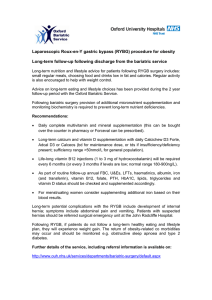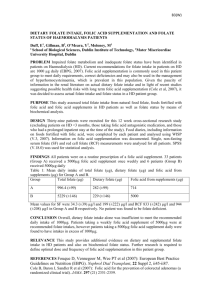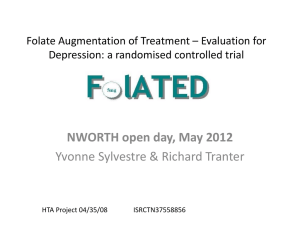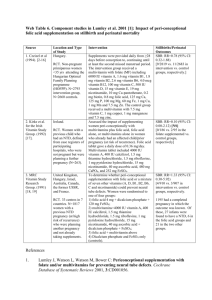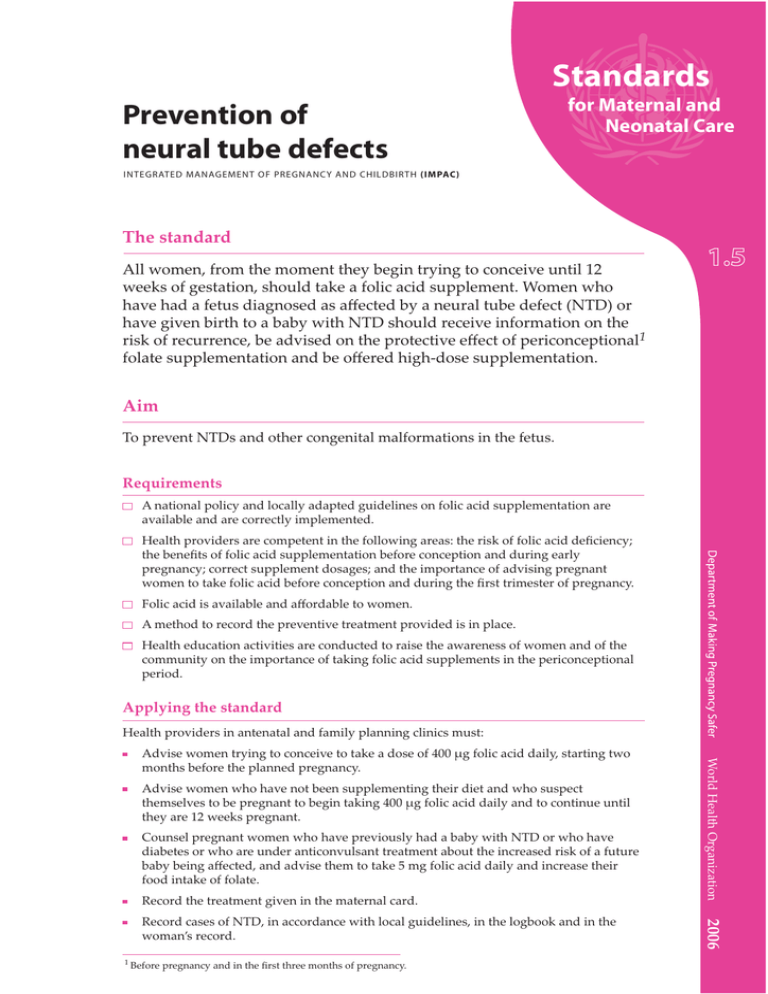
Standards
Prevention of
neural tube defects
for Maternal and
Neonatal Care
INTEGRATED MANAGEMENT OF PREGNANCY AND CHILDBIRTH (IMPAC)
The standard
All women, from the moment they begin trying to conceive until 12
weeks of gestation, should take a folic acid supplement. Women who
ȱȱȱȱȱȱěȱ¢ȱȱȱȱȱǻǼȱȱ
ȱȱȱȱȱ¢ȱ ȱȱȱȱȱȱȱ
ȱȱǰȱȱȱȱȱȱěȱȱ1
ȱȱȱȱěȱȬȱǯ
Aim
ȱȱȱȱȱȱȱȱȱǯ
Requirements
A national policy and locally adapted guidelines on folic acid supplementation are
available and are correctly implemented.
ȱ ȱȱȱȱȱȱ ȱDZȱȱȱȱȱȱę¢Dzȱ
ȱęȱȱȱȱȱȱȱȱȱ¢ȱ
¢DzȱȱȱDzȱȱȱȱȱȱȱ
ȱȱȱȱȱȱȱȱȱȱęȱȱȱ¢ǯ
ȱ ȱȱȱȱȱěȱȱ ǯ
A method to record the preventive treatment provided is in place.
Health education activities are conducted to raise the awareness of women and of the
community on the importance of taking folic acid supplements in the periconceptional
period.
Applying the standard
Health providers in antenatal and family planning clinics must:
Advise women who have not been supplementing their diet and who suspect
themselves to be pregnant to begin taking 400 μg folic acid daily and to continue until
they are 12 weeks pregnant.
ȱ ȱȱ ȱ ȱȱ¢ȱȱȱ¢ȱ ȱȱȱ ȱȱ
diabetes or who are under anticonvulsant treatment about the increased risk of a future
¢ȱȱěǰȱȱȱȱȱȱśȱȱȱȱ¢ȱȱȱȱ
food intake of folate.
Record the treatment given in the maternal card.
1
ȱ¢ȱȱȱȱęȱȱȱȱ¢ǯ
2006
ȱ ȱȱȱǰȱȱȱ ȱȱǰȱȱȱȱȱȱȱ
woman’s record.
World Health Organization
Advise women trying to conceive to take a dose of 400 μg folic acid daily, starting two
months before the planned pregnancy.
Standards
1.5
Preve nt i o n o f n e u ra l t u b e d e fe c t s
2
Audit
ȱ
Policy and local guidelines on folic acid supplementation are available in clinics.
ȱ ȱȱȱȱȱȱȱȱȱȱȱěȱȱȱȱ
family planning clinics.
ȱ ȱȱȱęȱȱȱȱȱȱȱȱȱ¢ȱȱȱ
and family planning clinics.
ȱȱȱ
ȱ ȱȱȱȱȱȱ ȱȱȱȱ ȱȱȱȱȱȱȱ
ȱȦȱȱȱęȱŗŘȱ ȱȱ¢ǯ
ȱ ȱȱȱ ȱȱȱȱȱȱȱȱȱ
period.
ȱ
Incidence of neural tube defects in the newborn.
Rationale
ȱȱě
ȱȱȱȱȱȱȱ
congenital malformations in neonates
worldwide (1)ǯȱ¢ȱȱȱ
heterogeneous group of disorders that occur
ȱȱęȱ ȱȱǰȱȱ
ęȱȱȱȱȱȱȱȱ
derivatives (1,2)ǯȱȱȱȱȱȱ
the general population varies from 1 per 1000
pregnancies in the USA to 12 per 1000 in parts
of Ireland and Wales and among Indian Sikhs
and certain ethnic groups in Egypt (1,2).
ȱ¡ȱȱȱȱȱȱ Dzȱ
ȱşśƖȱȱȱȱ ȱȱȱ
family history (1,2)ǯȱǰȱȱȱȱ
ȱȱŗȱȱřřȱȱ ȱȱěȱ
pregnancy and 1 in 10 for those with two
ěȱȱ(1). Sisters of women
ȱȱěȱȱȱȱŗȱȱŗŖŖȱȱȱ
ȱȱȱȱ ȱȱěȱȱȱȱŗȱ
in 300 risk (1)ǯȱȱȱȱ£ȱęȱ
have been proposed as possible causes. Known
factors associated with higher risk include
maternal diabetes, alcohol abuse by the
mother, aminopterin ingestion and antenatal
Ȭȱ(1). Suspected contributing
factors are anticonvulsant therapy, maternal
¢ǰȱȱ¡ȱȱȱ
and hallucinogen ingestion (2).
Ĝ¢ȱȱě
Folic acid supplementation before conception
ȱȱȱęȱȱȱ¢ȱ
is one of the few public health interventions
ěȱȱȱȱȱȱȱ(2–5).
Controlled randomized clinical studies
showed that folic acid supplementation
during the perinatal period reduced the risk
of recurrence in women who had previously
ȱȱȱ ȱȱ(3)ǯȱȱȱ
indicates that periconceptional folate
supplementation reduces the incidence of
ȱȱȱȱȱ(2,4,5)ǯȱȱ
ȱȱȱȱęȱȱȱ
cases of defects. Owing to the heterogeneous
¢ȱȱǰȱ ǰȱȱȱȱȱ
eliminated by this intervention.
Among other factors possibly associated with
ȱȱȱȱȱȱȱ
methylenetetrahydrofolate reductase gene
ǻȱŜŝŝȱȱǼȱ(6), but it is not
ȱȱȱȱȱȱȱȱ
ěȱȱ ȱ ȱȱȱȱ
is reduced by a higher intake of folate
(7). It is also unclear whether there is a
link between vitamin B12ȱę¢ȱȱ
ȱ(8), but any future supplementation
scheme could also include this vitamin (4,9).
Folate supplementation could be especially
ȱȱ ȱȱȬ
depleting treatment, such as with antiepileptic
drugs (2,10)ǰȱǰȱ¡ǰȱ
¡£ȱȱ¢ǰȱȱ
ȱȱȱȱȱȱȱęȱ
conclusion.
Randomized trials, supported by many
observational studies, indicate that
periconceptional use of folic acid in
multivitamin supplements reduces the overall
ȱȱȱǰȱȱĞȱ¡ȱ
ȱ(11)ǯȱȱȱȱȱȱ
be due to a reduced risk of cardiovascular
ȱǻȱȱřŚȬśŞƖȱȱěȱ
Ǽǰȱȱȱǻȱȱ
Standards
1.5
Preve nt i o n o f n e u ra l t u b e d e fe c t s
řŖƖǼǰȱȱęȱǻȱȱŚŜȬŞŗƖǼǰȱ
¢ȱȱǻȱŚŖȬŞřƖǼǰȱȱ
onphalocele and imperforate anus.
Folate supplementation has been associated
with a small increase in multiple gestation, but
a recent systematic review does not support
ȱęȱ(3)ǯȱȱȱěȱȱȱ
supplementation have been demonstrated,
either in the short or the long term (2,12).
However, if an increase in multiple gestation is
ęǰȱȱȱȱ¢ȱȱȱ
ȱęȱȱȱǯȱȱ
ěȱȱȱǰȱȱȱ
developed and in less developed countries,
depends on informing women of childbearing
age and on the ability to plan a pregnancy
(13). Possible alternatives or complements
to giving folate supplements as pills could
3
be information on changing the diet (7,14)
ȱȱęȱ(5), although these
ȱȱȱȱěȱȱ
increasing plasma folate levels owing to lower
bioavailability (5,7,14)ǯȱȱȱęȱȱ
employed, it is recommended that a higher
ȱȱȱǻřśŖȱΐȦŗŖŖȱȱǼȱȱȱ(15).
ȱȱȱȱĴǰȱȬȱ
ęȱȱȱȱȱȱȱ
ęȬȬȱȱ(15). It is still unclear as to
ȱȱȱȱȱ¢ȱȱ
ȱȱȱȱȱȱǯȱȱ
ȱȱ¢ȱȱȱȱęȱȱȱ
ȱȱ ȱȱȱęȱȱ
ȱȱ ȱDzȱȱȱȱ¢ȱ
to the possibility of masking pernicious
anaemia in elderly patients who receive folate
supplementation (4).
ȱȱ ȱ£ȱȱȱȱȱȱȱǯȱȱȱȱȱȱ
ȱȱȱȱ¢ȱ ȱȱȱȱȱŗȱǻȱǼȱȱŚȱǻ ȱǼǯȱȱȱȱ
For details, see also the Introduction to the Standards for Maternal and Neonatal Care and the Process to
develop the Standards for Maternal and Neonatal CareȱȱĴDZȦȦ ǯ ǯȦȏ¢ȏȦ
publications/en. For an overview of a comprehensive list of evidence, please refer to the reference
section of the standard.
Study
(Type &
ȱȱ
Ǽ
2. Lumley
et al. 2004
Most recent
substantive
amendment
April 2001
¢ȱ
ȱ
1++
Şǯȱ¢ȱȱǭȱ
Blom 2003
¢ȱ
ȱȱȱ
ȱȱ
studies
Population &
Ĵ
ȱǭȱ
ŚȱǰȱŜŚŘśȱ
Australia, Canada,
France, Hungary,
Ireland, Israel,
United Kingdom,
countries of the
former USSR
Baseline risk of
ȱȱȱȱȱȱȱȱȱȱȱȱȱȱȱȱȱȱȱȱȱȱȱȱȱ
ȮȱȱŖǯŘƖȱ
Ȯȱ¡ȱŝǯŞƖ
ŗŝȱȬȱ
studies were
included, mean
sample size 33 cases
and 93 controls.
ȱȱȱěȱ
of periconceptional
increased consumption of
folate or multivitamins on
ȱȱȱȱ
ȱ
linked to the
standard
Results
Comments
ȱ
Folate + vitamin
supplement vs control
– minimum
– ¡
ȱ ȱŜşŚȱǻśŝśȮŗŗşŖǼȱ
ȱŗŞȱǻŗśȮřŖǼȱȱȱȱȱȱȱȱȱȱȱȱ
ŚȱǰȱŜŚŘŚȱ
ȱȱȱ
folate alone vs
vitamins alone showed
ȱȱȱȱ
is due to folate and not
to vitamins
a
b
Miscarriage
ȱȱȱȱȱȱ
ȱȱȱŖǯřŜȱȱ
4 mg/day
ȱȱ
association between
low maternal B12 and
increased risk of fetal
2++
řȱǰȱŝŜŖŖȱ
Stillbirth
řȱǰȱŝŜŖŖȱ
Multiple
gestation
řȱǰȱŜŘŚŗȱ
Low level vs high level
of serum vitamin B12
Odds ratio 0.9–13.3
ǻŖǯŚȮŜśǯśǼ
ȱȱȱȱȱ
moderate association
between low maternal
vitamin B12 status and
ȱȱȱȱDzȱ
ȱęȱȱ
can be drawn
a
ȱȱȱȱȱȱȱȱȱȱȱbȱȬę
1.
Cloherty JP, Stark A, Eichenwald E. Manual of neonatal care.ȱĴȱȱǭȱǰȱ
ŗşşŞǯ
2.
Lumley J et al. Periconception supplementation with folate and/or multivitamins to prevent
ȱȱȱǻȱ ǼǯȱDZȱThe Cochrane Library, Issue 4, 2001. Chichester,
ȱ¢ȱǭȱǰȱŘŖŖŗǯ
řǯȱ ȱȱȬȱǯȱȱ¢ȱȱĜ¢ȱȱȱȱ
acid containing vitamin supplementation in prevention of open neural tube defects from
India. Indian Journal of Medical ResearchǰȱŘŖŖŖǰȱŗŗŘDZŘŖŜȮŘŗŗǯ
Standards
1.5
Preve nt i o n o f n e u ra l t u b e d e fe c t s
4
Śǯȱ ȱȱȱǯȱ¢ȱȱěȱȱȱǯȱLancetǰȱŘŖŖŗǰȱřśŞDZŘŖŜşȮŘŖŝřǯ
śǯȱ ȱȱȱǯȱȱȱȱęȱȱ¢ȱȱȱȱȱ
¢ȱȱȱęȱȱȱȱǯȱTeratologyǰȱŘŖŖŘǰȱŜŜDZřřȮřşǯ
Ŝǯȱ ȱȱȱǰȱȱǰȱȱ
ǯȱȱȱȱŜŝŝ ȱȱȱȱ¢
¢ȱȱȱȱȱȱȱȱȱǵȱȱȬ¢ǯȱQJM: An
International Journal of MedicineǰȱŗşşŝǰȱşŖDZŗŗŗȮŗŗśǯ
ŝǯȱ ęȬĴȱȱȱǯȱ¢¢ȱȱŜŝŝ ȱ¢ȱȱ
¢ȱȱȱȱȬȱȱȱȱ ȬȱȱȱDZȱȱ£ȱ
controlled trial. American Journal of Clinical NutritionǰȱŘŖŖŘǰȱŝŜDZŗŞŖȮŗŞŜǯ
Şǯȱ ¢ȱǰȱȱ
ǯȱȱ12ȱĜ¢ȱȱȱȱȱȱȱȱǯȱQJM: An
International Journal of MedicineǰȱŘŖŖřǰȱşŜDZŘŞşȮŘşśǯ
şǯȱ ȱȱȱǯȱěȱȱȱȱȱȱȱȱȱȱȱȬŗŘȱȱ
plasma homocysteine concentrations in healthy, young women. American Journal of Clinical
NutritionǰȱŗşşŞǰȱśDZŗŗŖŚȮŗŗŗŖǯ
10. Yerby MS. Management issues for women with epilepsy: neural tube defects and folic acid
supplementation. NeurologyǰȱŘŖŖřǰȱŜŗDZŘřȮŘŜǯ
11. Czeizel AE. Periconceptional folic acid containing multivitamin supplementation. Eur J Obstet
Gynecol Reprod BiolǯȱŗşşŞȱDzȱŝŞǻŘǼDZŗśŗȮŜŗǯ
ŗŘǯȱ ȱǰȱ££ȱǯȱȬȱȱȱȱȱȱȱĞȱ
periconceptional multivitamin supplementation. European Journal of PediatricsǰȱŗşşŞǰȱşDZŝŗşȮŝŘřǯ
ŗřǯȱ ȱǯȱ¢ȱȱȱ¢ȱȱȱǯȱAmerican Journal of
Obstetrics and GynecologyǰȱŗşşŚǰȱŗŝŖDZŗŚŞśȮŗŚŞşǯ
ŗŚǯȱ ȱȱȱǯȱ¢ȱȱȱȱȱȱDZȱȱ£ǰȱȬ
ȱȱȱȬȱȱȱȱěȱȱȱȱȱȱȱ
homocysteine. American Journal of Clinical NutritionǰȱŘŖŖŘǰȱŝŜDZŝśŞȮŝŜśǯ
ŗśǯȱ ȱȱȱǯȱȱȱęȱȱDZȱȱȱ¢ǯȱAmerican Journal of
Public HealthǰȱŗşşśǰȱŞśDZŜŜŝȮŜŝŜǯ
ȱȱȱ
I.
ȱǯȱȱĞȱ. London, Royal College of Obstetricians and
Gynaecologists, 1999.
II. Pregnancy, childbirth, postpartum and newborn care: a guide for essential practice. Geneva, World
ȱ£ǰȱŘŖŖřȱǻĴDZȦȦ ǯ ǯȦȦŘŖŖřȦşŘŚŗśşŖŞŚǯǰȱ
ȱŝȱȱŘŖŖŚǼǯ
ȱȱ
is not a formal
publication of
the World Health
Organization
ǻ
Ǽǰȱȱ
all rights are
reserved by the
Organization.
ȱȱ
may, however, be
freely reviewed,
abstracted,
reproduced and
translated, in part
or in whole, but
not for sale nor for
ȱȱȱ
with commercial
purposes.
ȱȱȱȱȱȱ
Standards for Maternal and Neonatal
ȱȱ¢ȱȱȱ
ȱȱ¢ȱǰȱ
World Health Organization.
For further information please
:
ȱȱȱ¢ȱ
ȱǻǼ
ȱ
ȱ£ȱǻ
Ǽ
20 Avenue Appia
ŗŘŗŗȱȱŘŝ
Switzerland
DZȱƸŚŗȱŘŘȱŝşŗȱřřŝŗ
¡DZȱƸŚŗȱŘŘȱŝşŗȱśŞśř
Email: MPSinfo@who.int
ȱDZȱ ǯ ǯȦȏ
¢ȏȦȦȦ
ȱȱȱȱȱȱȱĴȱȱ
DZȱȱȱǰȱǰȱȱȱȱ
ȱȱDzȱȱȱȱȱȱȱȱȱȱȱȱ
ȱĴǰȱ
ȱǰȱȱĴǰȱȱǰȱȱȱȱȱȱȱ
ǻȱȱȱ¢ȱǼǯ
ȱȱȱȱȱȱȱȱȱȱȱȱȱȱȱȱȱȱȱȱȱȱȱȱȱȱȱȱȱȱȱȱȱȱȱȱȱȱȱȱȱȱȱȱȱȱȱȱȱȱȱȱȱȱȱȱȱȱȱȱȱȱȱȱȱȱȱȱȱȱȱȱȱȱȱȱȱȱȱȱȱȱȱȱȱȱȱȱȱȱȱȱȱȱȱȱ
ȱȱ ȱȱ¢ȱȱĴȱ ȱȱȱȱȱ
ȱȱȱȱĴȱȱ
ȱȱĜȱȱ ȱȱȱȱ
ȱȱǰȱŗŚȬŗŜȱȱŘŖŖŘǯȱȱȱȱȱȱȱȱ
ěȱȱȱȬȱǻȱȱǰȱĴȱǰȱȱǰȱ
ȱĴǰȱȱȱȱȱǼȱȱȱȱȱȱȱ
provided additional insightful review of the evidence section. We thank Bruno de Benoist
ȱ ȱęȱĞǰȱȱȱȱȱȱȱȱ¢ȱȱȱ¢ǯ
ȱ ȱȱȱȱȱȱŞŖȱȱȱ£ȱȱ
ȱęȱȱȱȱȱȱ ȱȱȱȱ ȱȱȱȱěȱ
stages of its development.
ȱȱ ȱȱȱȱȱȱȱȱȱ¢ȱȱȱ
Governments of Australia, Italy and USA is gratefully acknowledged. In addition, WHO’s
ȱ¢ȱȱȱȱȱȱȱȱȱǰȱǰȱ
ǰȱ ¢ǰȱ ǰȱȱȱȱǰȱȱȱȱȱǰȱȱȱȱȱ
ȱȱȱęȱȱǯȱ

